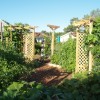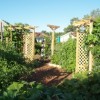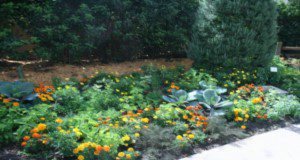Maintaining edible landscapes in a way that protects the environment is an important concern for protecting Florida’s water quality. The objective of this new 7-page publication is to introduce the framework of the Florida-Friendly Landscaping™ principles and apply the principles to guide decisions about Best Management Practices (BMPs) for care of edible landscapes. Written by Tiare Silvasy, Lynn Barber, Esen Momol, Tina McIntyre, Tom Wichman, Gail Hansen, Jen Marvin, Terra Freeman, Joseph Sewards, Wendy Wilber, and Jacqlyn Rivas.
https://edis.ifas.ufl.edu/ep594
Tag: Edible Landscapes
Landscape Design with Edibles (ENH1214/EP475)
 Although design basics for edible ornamental landscapes are essentially the same as strictly ornamental landscapes, a few details ensure the success of the edible landscape. Gardens with plants that change considerably with the seasons rely more on an organized yet interesting layout, appealing support structures, functional pathways, and colorful containers and planters to provide interest and beauty when the plants are not taking center stage. There are twelve important ideas to consider when creating a successful edible ornamental garden. This 4-page fact sheet was written by Gail Hansen, and published by the UF Department of Environmental Horticulture, May 2013.
Although design basics for edible ornamental landscapes are essentially the same as strictly ornamental landscapes, a few details ensure the success of the edible landscape. Gardens with plants that change considerably with the seasons rely more on an organized yet interesting layout, appealing support structures, functional pathways, and colorful containers and planters to provide interest and beauty when the plants are not taking center stage. There are twelve important ideas to consider when creating a successful edible ornamental garden. This 4-page fact sheet was written by Gail Hansen, and published by the UF Department of Environmental Horticulture, May 2013.
http://edis.ifas.ufl.edu/ep475
Design and Implementation of Edible Plant Demonstration Gardens: A Case Study of the Putnam County Extension Edible Garden (ENH1205/EP466)
 Demonstration gardens are a collection of plants assembled and organized in a manner that allows garden visitors to access and study them. Most gardens are designed with a particular focus and include plants that support the purpose and educational theme of the garden. This case study features an edible plant demonstration garden that was designed and installed in Hastings, Florida, on the Extension office grounds. The UF/IFAS program and the Partnership for Water, Agriculture, and Community Sustainability (FPWACS) designed and implemented the demonstration garden using a step-by-step process that is discussed in this 15-page fact sheet written by Gail Hansen, Joseph Sewards, Rebecca Almeida, and Andrew Dunn, and published by the UF Department of Environmental Horticulture, November 2012.
Demonstration gardens are a collection of plants assembled and organized in a manner that allows garden visitors to access and study them. Most gardens are designed with a particular focus and include plants that support the purpose and educational theme of the garden. This case study features an edible plant demonstration garden that was designed and installed in Hastings, Florida, on the Extension office grounds. The UF/IFAS program and the Partnership for Water, Agriculture, and Community Sustainability (FPWACS) designed and implemented the demonstration garden using a step-by-step process that is discussed in this 15-page fact sheet written by Gail Hansen, Joseph Sewards, Rebecca Almeida, and Andrew Dunn, and published by the UF Department of Environmental Horticulture, November 2012.
http://edis.ifas.ufl.edu/ep466
